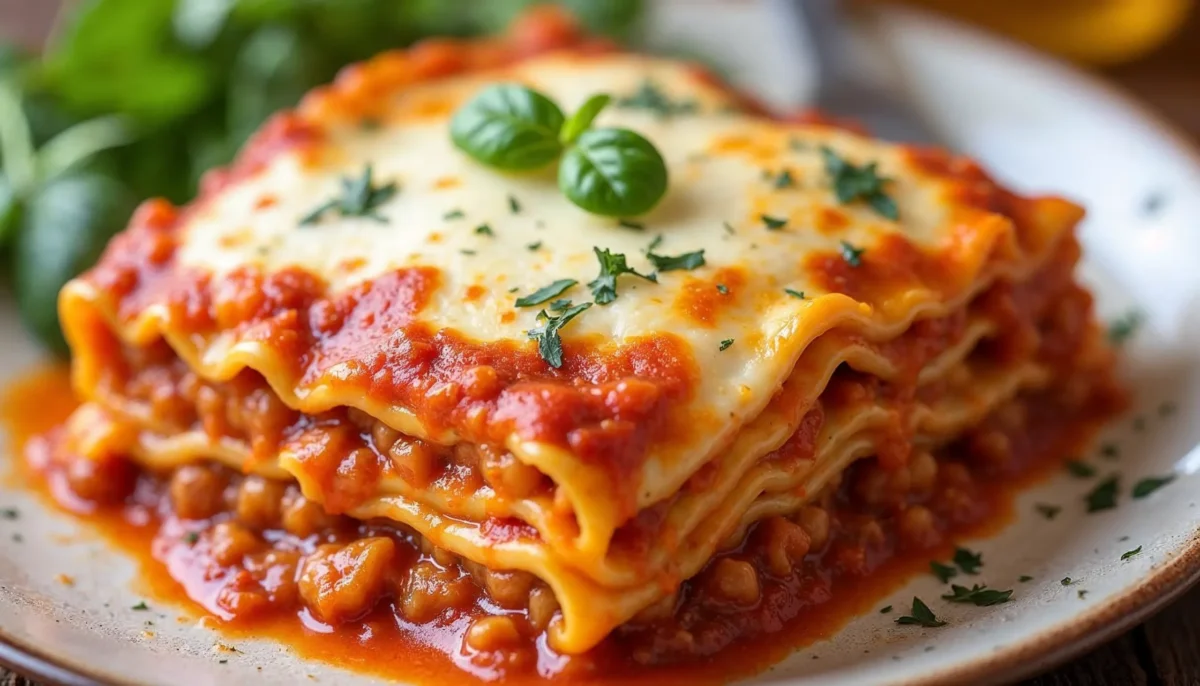11 Essential Tips to Make Perfect Homemade Lasagna Every Time
Creating the best family-style lasagna is an art that combines the right ingredients with the perfect technique. Whether you’re a seasoned chef or a beginner in the kitchen, understanding the nuances of creating lasagna can elevate your dish from good to unforgettable. From selecting the right pasta to perfecting your meat-based sauce, this guide will show you How to make lasagna more moist.
How to make lasagna more moist: the Key Lasagna Ingredients?
How to Choose the Ideal Pasta for Lasagna?
The foundation of any noodle dish is its pasta. When choosing lasagna noodles, consider whether you prefer fresh lasagna sheets or the convenience of store-bought dried options. Fresh lasagna sheets offer a tender texture that many find appealing, while dried noodles provide a firmer bite. If you opt for dried noodles, look for those labeled as “no-boil” or “oven-ready,” which can be used directly without pre-cooking. These types of pasta bakes absorb moisture from the sauce, resulting in perfectly baked layers that won’t end up runny.
How to make lasagna more moist: What type of Ricotta Cheese Should You Use?
Ricotta cheese is a crucial component in achieving the creamy texture that defines a delicious pasta bake. When selecting ricotta, choose a high-quality, whole milk type for a richer flavor. If you’re looking to reduce calories, part-skim ricotta can be a suitable substitute without sacrificing too much taste. For a twist, consider mixing ricotta with fresh mozzarella or Italian cheese to enhance the cheese layer’s flavor profile, making it more complex and satisfying.
How to make lasagna more moist: Select the Perfect Meat for Your Lasagna.
The meat-based sauce is the heart of your pasta bake, and choosing the right meat is essential for a flavorful result that will have everyone checking their inbox for the recipe. Ground beef is a popular choice due to its robust flavor, but a combination of ground beef and pork can add depth to your sauce. If you prefer a lighter option, ground turkey or chicken can be used as a substitute. Whatever meat you choose, browning it thoroughly before adding it to your sauce will enhance its flavor and ensure the meat-based sauce is not greasy.
How to make lasagna more moist: Prepare lasagna with Perfectly Baked Noodles.
Should You Cook Lasagna Noodles Before Baking?
Cooking noodle dishes before baking is a topic of much debate. While some traditionalists insist on boiling noodles first, many modern recipes call for uncooked noodles to simplify the process. No-boil lasagna noodles are designed to cook in the oven, absorbing sauce moisture and resulting in perfectly tender layers. If using traditional noodles, boiling them until slightly undercooked will prevent them from becoming mushy during baking.
How to make lasagna more moist: Layer Noodles for the ideal Lasagna.
The art of layering is crucial to making the ideal noodle dish. Start with a thin layer of sauce at the bottom of your baking dish to prevent sticking. Add a single layer of noodles, followed by ricotta, meat-based sauce, and a sprinkle of mozzarella and parmesan. Repeat these layers, ensuring each is evenly distributed to maintain a balance of flavors and textures. The top layer should be a generous amount of sauce and cheese to create a golden, bubbly crust when baked.
What Are the Ideal Baking Conditions for Lasagna?
Baking conditions can make or break your casserole. Preheat your oven to 375°F (190°C) for optimal results. Cover your casserole with foil for the first half of the baking time to prevent the top layer from burning. After about 25 minutes, remove the foil to allow the cheese to brown and bubble. Total cooking time should be around 45 minutes to an hour, depending on the depth of your noodle casserole. Letting it rest for at least 15 minutes before serving will help the layers set and enhance the flavors.
How to Prepare a Delicious Lasagna Meat Sauce?

How to Thicken Your Meat-based Sauce?
A thick, hearty meat-based sauce is essential for a satisfying pasta bake. To thicken your sauce, simmer it on low heat to allow the liquids to cook down and reduce. Adding tomato paste can also help achieve the desired consistency without compromising flavor. Avoid rushing this process, as a well-reduced sauce will cling better to the noodles and contribute to a cohesive dish.
What Spices Add the top Flavor to noodle casserole?
Spices are the secret to a flavorful meat-based sauce. Classic Italian herbs like oregano, basil, and thyme are staples that complement the tomatoes and meat. For an extra kick, add a pinch of red pepper flakes or freshly ground black pepper. Garlic, whether minced fresh or in powder form, is a must-have for depth of flavor. Adjust these spices to suit your taste buds, ensuring that each bite of your noodle dish is bursting with flavor.
How to Balance Meat and Tomato in Your Sauce?
Balancing the ratio of meat to tomato in your sauce is critical for a harmonious noodle dish that delivers the answer you’re looking for in flavor. Too much meat can overpower the dish, while an excess of tomato can make it too acidic. A good rule of thumb is to use equal parts ground meat and crushed or chopped tomatoes. Incorporating a splash of wine or a touch of sugar can help mellow the acidity of the tomatoes, creating a balanced sauce that enhances your noodle casserole layers.
How to Assemble and roast family-style lasagna?

How to make lasagna more moist: the Correct Order for Lasagna Layers?
The correct order of layering is a fundamental aspect of assembling lasagna. Start with a base of sauce to prevent noodles from sticking to the pan. Follow with a layer of uncooked noodles, a spread of ricotta cheese, a generous helping of meat sauce, and a sprinkling of mozzarella or parmesan. Repeat these layers of noodle dish until your ingredients are used, finishing with a top layer of sauce and cheese. This method ensures a well-structured baked pasta with distinct and flavorful layers.
How Much Cheese Should You Add to Each Layer?
It’s the cheese that gives lasagne its irresistible richness and creaminess.. While there’s no exact science to cheese quantities, a good rule is to add enough mozzarella and parmesan to each layer to cover the surface but not so much that it overwhelms the other ingredients. Aim for a balance where the cheese complements rather than dominates, ensuring a harmonious blend of flavors and textures.
How Long Should Lasagna cook in the Oven?
The cooking time for baked pasta is crucial for achieving the perfect texture. Typically, casserole should cook for 45 minutes to an hour at 375°F (190°C). Cover the dish with foil for the first half of the cooking time to prevent over-browning, then remove the foil to allow the top to develop a golden crust. After cooking, let the baked pasta rest for at least 15 minutes; this resting period helps set the layers and makes serving easier, just like verifying your email ensures a smooth process.
What Are the Best Tips to Cook Lasagna Every Time?
Why Should You Let Lasagna Rest Before Serving?
Letting casserole rest before serving is a step that should not be overlooked. Allowing it to rest for 15 to 20 minutes after cooking gives the layers time to set, making it easier to cut and serve. This resting period also lets the flavors meld, resulting in a more cohesive and delicious lasagna that respects your privacy policy regarding food safety. Skipping this step may lead to a messy presentation and uneven texture.
How to Store and Reheat Leftover Lasagna?
Proper storage and reheating of leftover lasagna can extend its deliciousness beyond the initial meal. To store, refrigerate lasagna in an airtight container for up to four days. For longer storage, freeze individual portions wrapped tightly in foil and placed in a freezer-safe bag. Reheat refrigerated lasagna in a 350°F (175°C) oven for about 20 minutes, or microwave individual servings until heated through. For frozen baked pasta, thaw in the refrigerator overnight before reheating.
What Are Common Mistakes to Avoid When Making Lasagna?
Even seasoned cooks can make mistakes when preparing noodle dishes. One common pitfall is overfilling the pan, which can lead to overflow and uneven cooking. Another is not allowing enough time for the sauce to be reduced, resulting in a watery dish. Additionally, using too much cheese can overwhelm the other flavors. To avoid these issues, be mindful of layer thickness, sauce consistency, and cheese quantity, ensuring a well-balanced and perfectly cooked lasagna every time.
FAQs
What kind of lasagna recipe should I use to make perfect homemade lasagna?
To make perfect homemade lasagna, start with a classic ricotta lasagna or try a variation like lasagna with béchamel sauce. Choose a recipe that matches your taste preferences and dietary needs.
How can I prevent my lasagne from sticking together?
To prevent lasagne sheets from sticking together, cook them al dente in salted water and add a tablespoon of oil to the boiling water. After cooking, lay them flat on a clean kitchen towel to dry.
Should I use a glass or metal dish to bake a lasagna?
Both glass and metal dishes can be used to roast a lasagna, but a glass dish allows for even heat distribution, resulting in a more uniformly cooked dish. A metal dish, however, can help achieve a crispy edge.
How many layers of pasta should a lasagna have?
A traditional lasagna typically has four to five layers of pasta, but you can adjust this based on personal preference and the depth of your cooking dish.
Is it important to use less sauce when making lasagna?
Using less sauce can help prevent the lasagna from becoming too soggy. Balance the amount of marinara or tomato sauce with the other ingredients to achieve the desired consistency.
How do I make the sauce for lasagna?
To make the sauce for lasagna, you can use crushed tomatoes or marinara sauce as a base, adding herbs and spices to taste. You can also make a béchamel sauce for a creamy texture.
Join the Baking Community!
Loved this recipe? Follow me on Facebook and Instagram for more delicious ideas, baking tips, and behind-the-scenes fun! Share your banana bread creations with me by tagging @panoramarecipes—I can’t wait to see what you come up with!
Happy baking, and don’t forget to share your delicious creations with friends and family. After all, good food is meant to be enjoyed together!


